 |  |  |  |  |  |  |
 |  |  |  |  |  |  |
 Fécamp 1938 Fécamp 1938
|  Louvetot 2 Louvetot 2
|
|
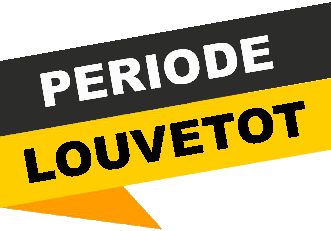 Le Centre émetteur de Louvetot Le Centre émetteur de Louvetot
The Louvetot Transmitter Centre
1
En service du mardi 13 décembre 1938 au jeudi 7*
septembre 1939
* en fait le vendredi 8 septembre (fin définitive des émissions à 1.00 du matin)
In
service from Tuesday, December 13, 1938 to Thursday, September 7, 1939
|
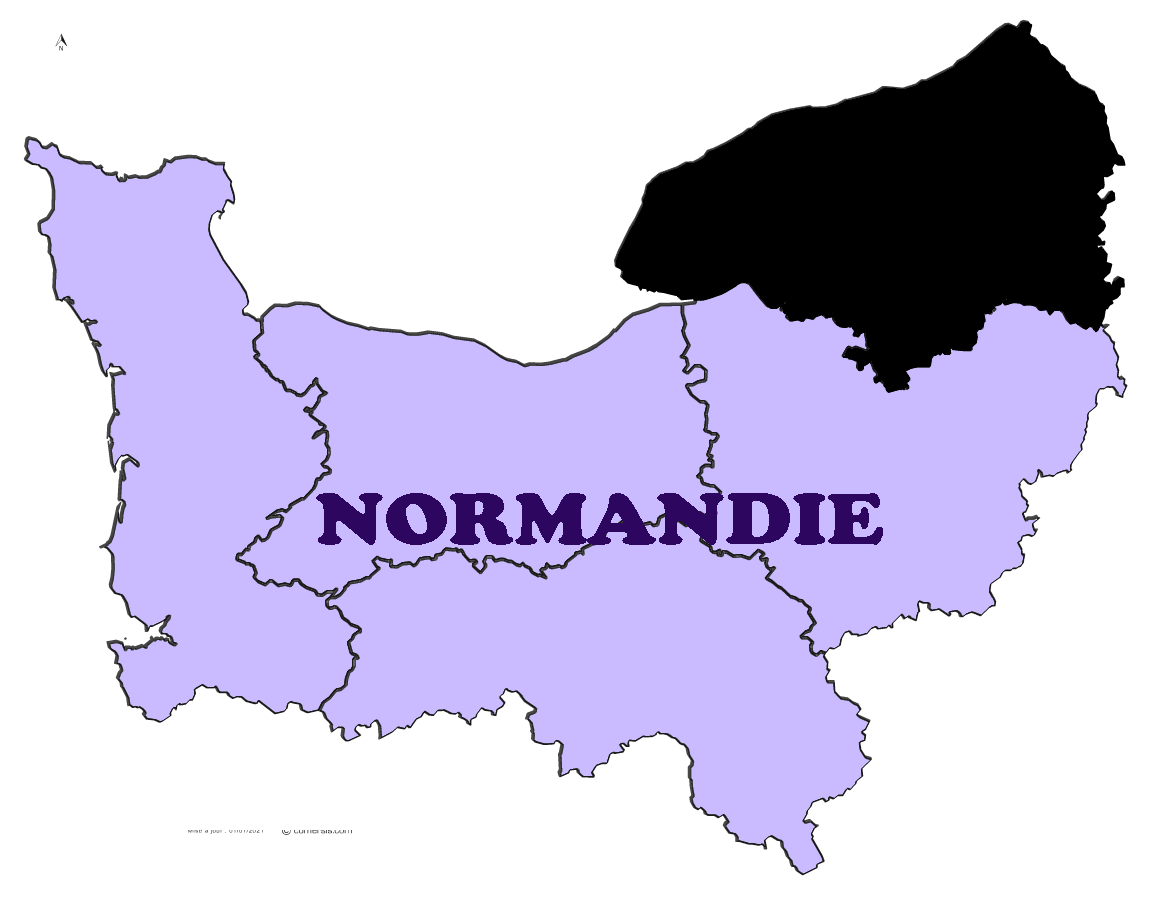 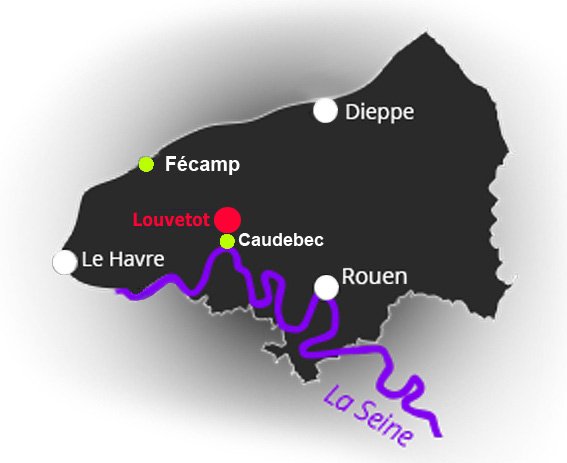
Seine-Maritime
anct "Seine-Inférieure"
|
|
Entretemps... In the meantime...
Vendredi 30 novembre 1935 : plus question de Mirville ni de Bréauté...
Construction d'un nouvel émetteur à Louvetot !
Construction of a new transmitter at Louvetot !
(35 km south-east Fecamp)
 Par décret du 7 août 1935, tout s’arrange. Le transfert de la station de Fécamp à Caudebec-en-Caux est autorisé. Un terrain est acheté sur le plateau de Louvetot et la première pierre des nouvelles installations est posée le 30 novembre en présence de Marcel Pellenc (photo >), autrefois inspecteur général des P.T.T. et pourfendeur de la radio privée. Au cours de cette cérémonie, le Capitaine Plugge, député conservateur de Rochester, qui s’occupe des intérêts de la station en Grande-Bretagne, déclare : « Plusieurs centaines de milliers d’Anglais écoutent votre poste d’émission. Et plus d’un quart accepte de payer bénévolement un shilling par an. » Quant à Marcel Pellenc, il avait bien changé d’avis depuis 1926, puisqu’il souligne : « La volonté du Ministre des PTT Georges Mandel est de permettre le développement des stations privées en même temps que celles de la radiodiffusion nationale. » Par décret du 7 août 1935, tout s’arrange. Le transfert de la station de Fécamp à Caudebec-en-Caux est autorisé. Un terrain est acheté sur le plateau de Louvetot et la première pierre des nouvelles installations est posée le 30 novembre en présence de Marcel Pellenc (photo >), autrefois inspecteur général des P.T.T. et pourfendeur de la radio privée. Au cours de cette cérémonie, le Capitaine Plugge, député conservateur de Rochester, qui s’occupe des intérêts de la station en Grande-Bretagne, déclare : « Plusieurs centaines de milliers d’Anglais écoutent votre poste d’émission. Et plus d’un quart accepte de payer bénévolement un shilling par an. » Quant à Marcel Pellenc, il avait bien changé d’avis depuis 1926, puisqu’il souligne : « La volonté du Ministre des PTT Georges Mandel est de permettre le développement des stations privées en même temps que celles de la radiodiffusion nationale. »
The transfer from Fécamp station to Caudebec-en-Caux is authorized. Land is purchased on the Louvetot plateau and the first stone of the new installations was laid on November 28 in the presence of Marcel Pellenc, former inspector general of the P.T.T. and slayer of private radio. During this ceremony, Captain Plugge, Conservative MP of Rochester, who looks after the station's interests in Great Britain, says: "Several hundred thousand English listen to your broadcast station. And more than a quarter agree to voluntarily pay one shilling per year". As for Marcel Pellenc, he had changed his mind since 1926, since he underlines: “The will of the Minister of PTT Georges Mandel is to allow the development of private stations at the same time as those of national broadcasting".
|

Vendredi 30/11/1935 : pose de la première pierre du futur centre émetteur de Louvetot (35 km au sud-est de Fécamp - 30 km à l'ouest de Rouen) en présence de Marcel Pellenc, inspecteur général de la radiodiffusion, représentant Georges Mandel, le ministre des PTT.
A droite : Monsieur Le Grand. Au fond, la route Yvetot - Caudebec déjà bien encombrée. Mais ce ne sont que les voitures officielles des invités
Friday 11/30/1935: laying of the first stone of the future Louvetot transmitter center (35 km south-east of Fécamp - 30 km west of Rouen) in the presence of Marcel Pellenc, general inspector of broadcasting, representing Georges Mandel, the minister of PTT.
Right: Mr Le Grand. In the background, the Yvetot - Caudebec road is already very congested. But these are only the official guest cars |
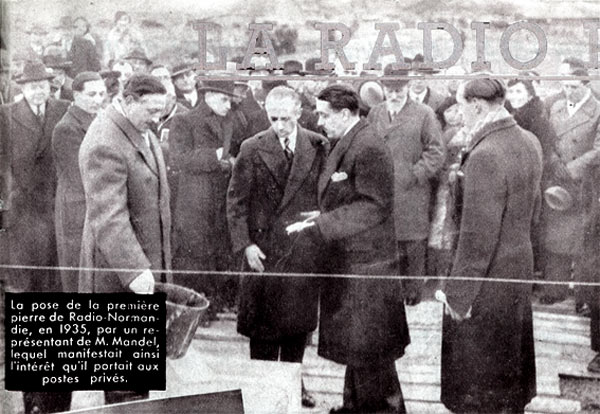
Marcel Pellenc (directeur de la radio nationale) et Fernand Le Grand le 30.11.1935. La pose de la première pierre de Radio Normandie par Marcel Pellenc représentant Georges Mandel, Ministre des PTT, lequel manifestait ainsi l'intérêt qu'il portait aux postes privés
Marcel Pellenc (director of national radio) and Fernand Le Grand on 30.11.1935. The laying of the first stone of Radio Normandie by Marcel Pellenc representing Georges Mandel, Minister of Post Office, who thus showed his interest in private radios
|
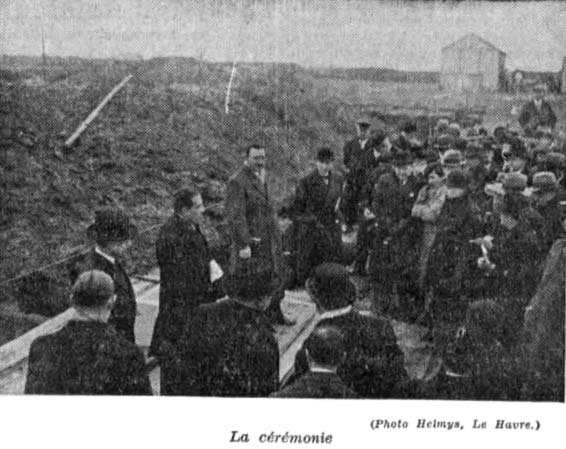
Voir notre "Revue de presse" (article dans le Journal de Rouen du 1er décembre 1935)
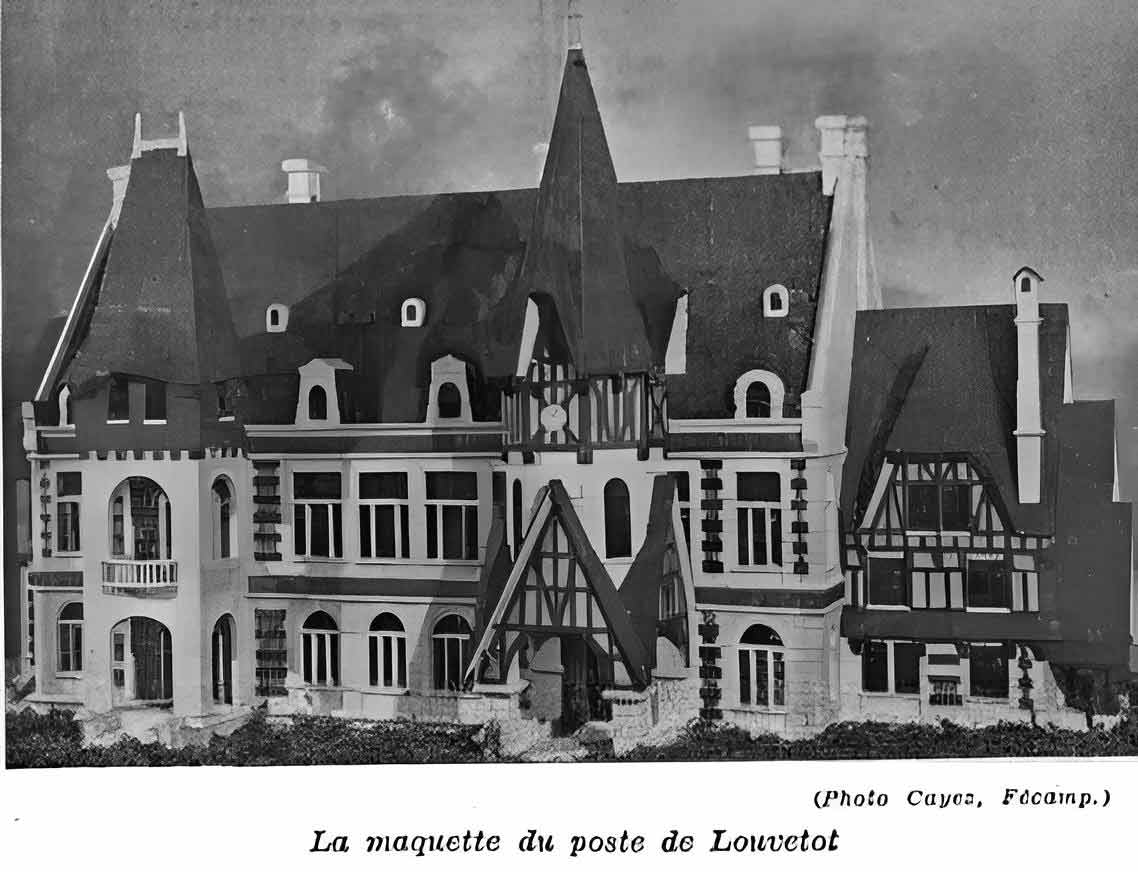
La tourelle de gauche (disgracieuse ?) ne sera pas construite dans le projet final
The left turret will not be built in the final project
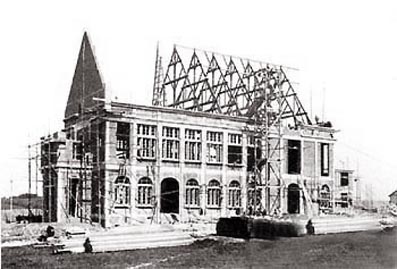
Entreprise Edouard Fontaine 1935 : les travaux du Centre de Louvetot, débutent le 28 novembre 1935, et vont se poursuivre sans relâche jusqu’au 12 décembre 1938, l'inauguration du Centre aura lieu le dimanche 4 juin 1939
Contractor Edouard Fontaine 1935 : work on the Louvetot Centre began on 28 November 1935 and will continue until December 12, 1938, the inauguration of the Centre will take place on Sunday, June 4, 1939. |
|
Par le décret du 7/08/1935, Georges Mandel, Ministre des PTT autorise le transfert de la station à Caudebec-en-Caux. En effet, les locaux sont devenus trop exigus à Fécamp et les antennes en pleine ville gênent la réception des autres stations.
"Le matériel de Fécamp sera déménagé de ses bâtiments trop étroits. L'emplacement nouveau permettra de couvrir d'une façon plus satisfaisante qu'actuellement les principaux centres de notre province. Actuellement à Fécamp, c'est par fils aériens que la modulation nous parvient et, par tempêtes ou orages, certaines transmissions sont difficiles. Cet inconvénient n'existera plus car un câble souterrain de six kilomètres nous réunira à Caudebec-en-Caux aux câbles souterrains à longue distance Paris-Rouen-Le Havre."
(Entretien de F. Le Grand au Journal de Fécamp 20/8/35) |
By the decree of 7/08/1935, Georges Mandel, Minister of PTT authorizes the transfer of the station to Caudebec-en-Caux. Indeed, the premises have become too cramped in Fécamp and the antennas in the middle of the city hamper the reception of the other stations.
"The equipment of Fécamp will be moved from its buildings which are too narrow. The new location will make it possible to cover in a more satisfactory way than at present the main centers of our province. Currently in Fécamp, it is by overhead wires that the modulation we succeeds and, in storms or thunderstorms, some transmissions are difficult. This inconvenience will no longer exist because a six-kilometer underground cable will connect us at Caudebec-en-Caux to the long-distance underground cables Paris-Rouen-Le Havre. "
(Interview by F. Le Grand in the Journal de Fécamp 8/20/35) |
|
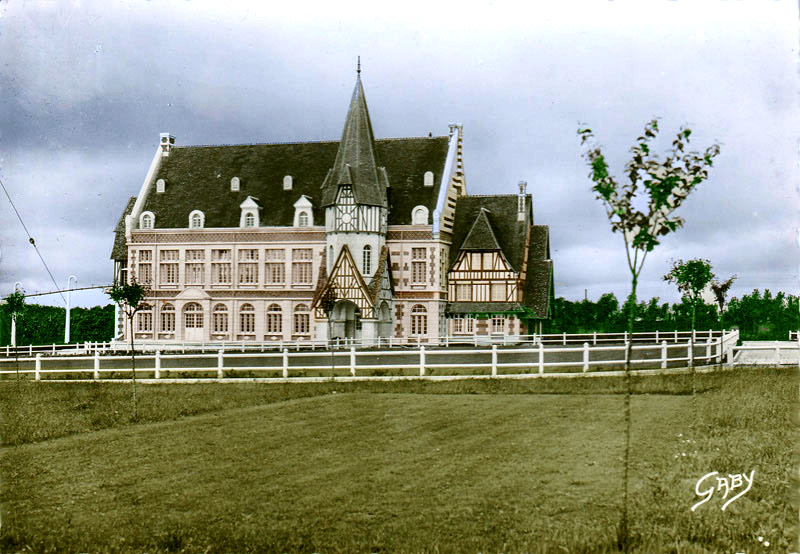
|
Le nouvel émetteur de Radio Normandie à Louvetot (1938-39) sous le ciel gris normand
The new Radio Normandie transmitter in Louvetot (1938-39) under the grey Normandy sky
|
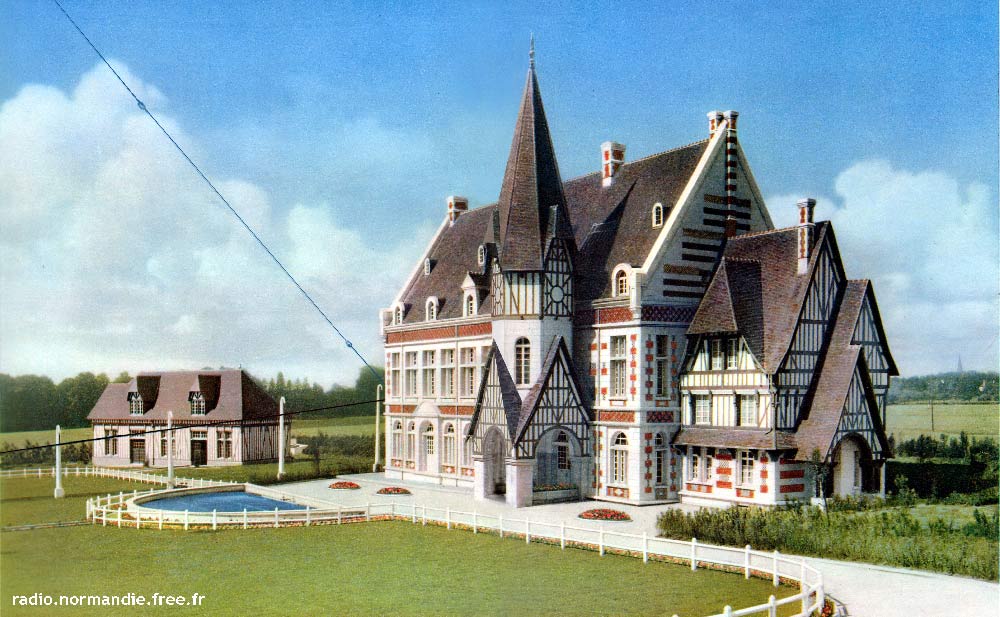
|
A gauche, le bâtiment abritant les générateurs. Le bassin servait au refroidissement de l'émetteur
situé au premier étage du bâtiment principal. Photo prise dès la mise en service en 1938
On the left, the building housing the generators. The basin was used to cool the transmitter
located on the first floor of the main building. Photo taken in 1938
Coordonnées géographiques : Latitude 49° 34' 23 N / Longitude 0° 43' 30 E - Altitude : 149 m |
Sur le plateau de Caux à Louvetot, sur un terrain de 3 hectares, on trouve un emplacement on ne peut plus favorable. L'entrepreneur est Fécampois et actif. Il a l'entière confiance du président qui le connaît bien : Edouard Fontaine. Au centre, il place le bâtiment de 53 m de long comprenant 4 étages au-dessus d'immenses caves et citernes. Au rez-de-chaussée, une salle des machines et un atelier ; au premier, l'émetteur, les accumulateurs, un laboratoire et un studio de secours. Dans la tourelle qui jouxte le bâtiment, le bureau du chef de poste. Au second étage : logements confortables pour les techniciens et au-dessus, un vaste grenier. |
On the plateau of Caux in Louvetot, on a plot of 3 hectares, we find a location one could not be more favorable. The entrepreneur is fécampois and active. He has the complete confidence of the president who knows him well : Edouard Fontaine. In the center, he places the 53 m long building with 4 floors above huge cellars and tanks. On the ground floor, an engine room and a workshop ; on the first, the transmitter, the accumulators, a laboratory and a rescue studio. In the turret that adjoins the building, the office of the postmaster. On the second floor : comfortable accomodation for technicians and above, a large attic. |
|
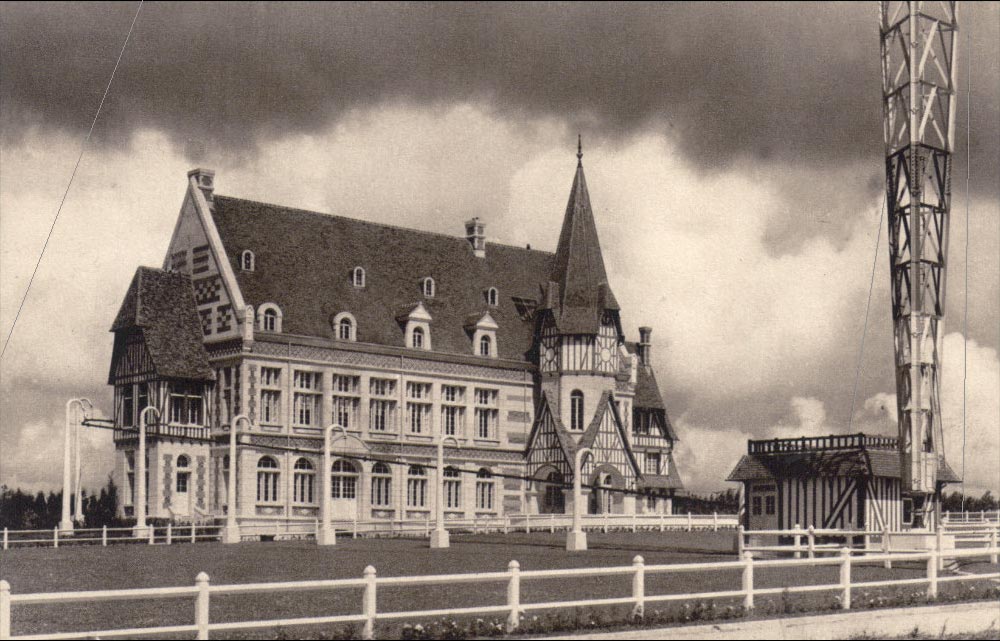
Remarquez le feeder (câble noir) qui relie l'émetteur de 25 kW au pylône "type Blaw-Nox" (hauteur : 154 m)
ainsi que la cabine d'accord au pied de l'antenne, décorée en pur style normand)
Note the feeder (black cable) that connects the 25 kW transmitter to the "Blaw-Nox" pylon (height: 154 m)
and the tuning cabin at the foot of the antenna, decorated in pure Norman style)
|
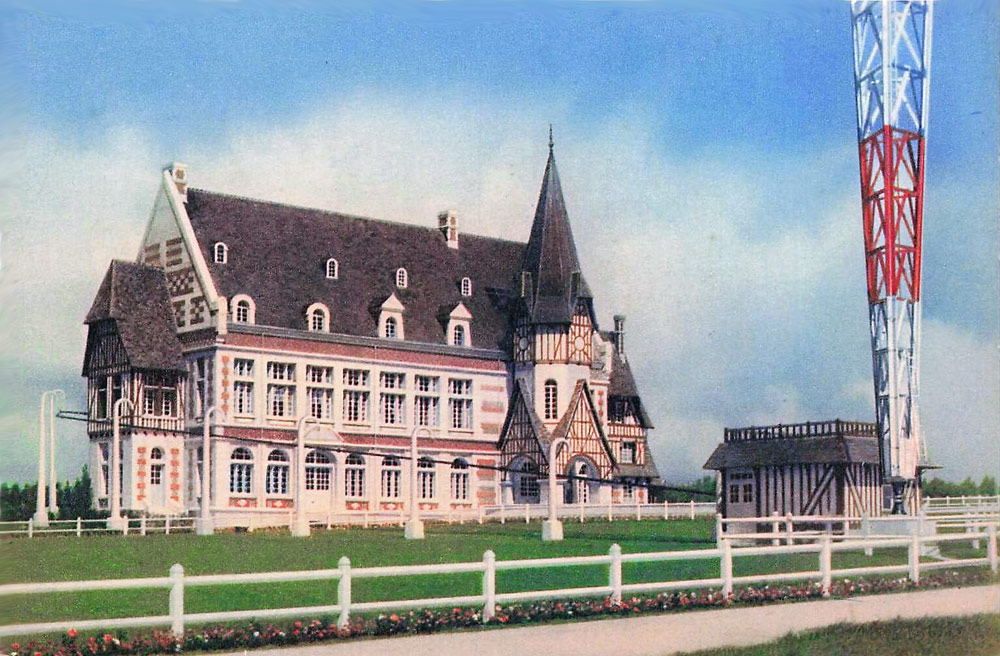
La même carte postale colorisée (le ciel normand menaçant est devenu bleu !)
Les câbles de haubans ont été gommés : sans doute jugés disgracieux pour une carte postale ?
The same colorized postcard (the threatening sky is painted blue!)
The shrouds cables have been erased: unsightly for a postcard?
|
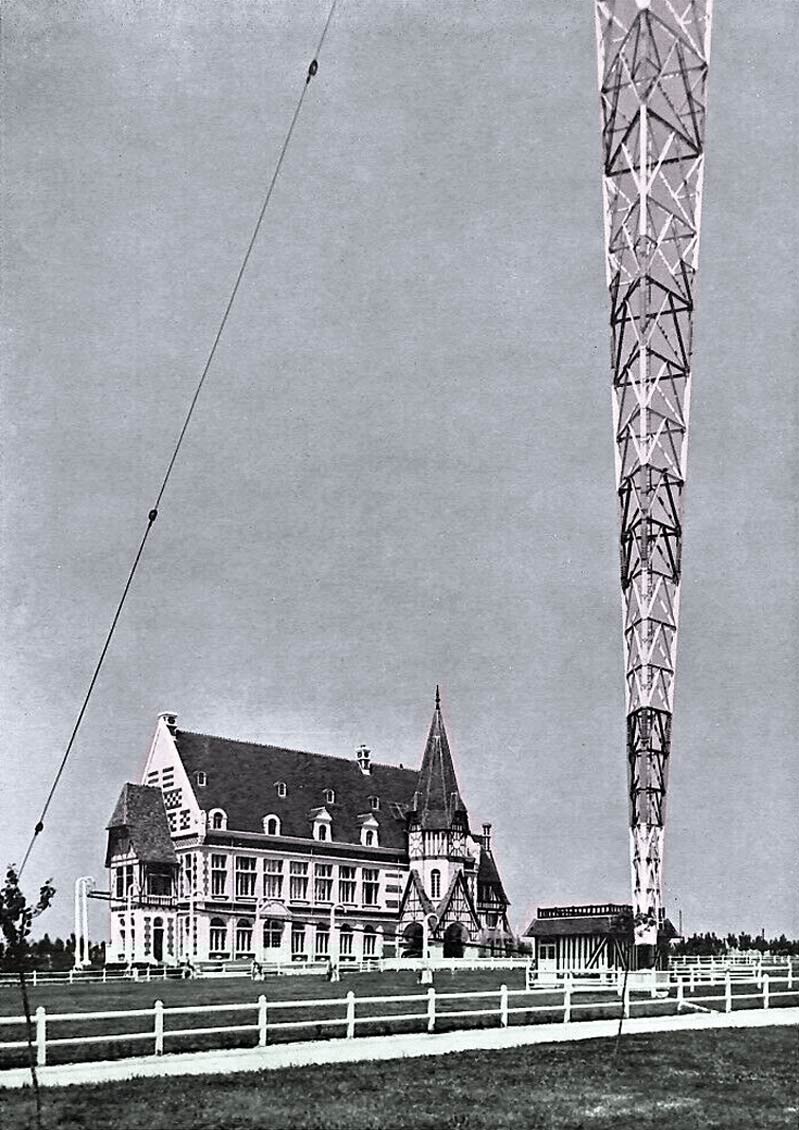

Détail de l'arrivée de l'énergie sortie depuis l'arrière gauche du bâtiment, jusqu'au pied du pylône. Sept "crosses" en ciment
supportent le "feeder", un tuyau de porcelaine recouvert de cuivre. L'émetteur "sortait" un signal de 25 kW
Detail of the energy output from the left rear of the building up to the foot of the pylon. Seven cement "crosses" support
the "feeder", a porcelain pipe covered with copper. The transmitter "output" a signal of 25 kW
|
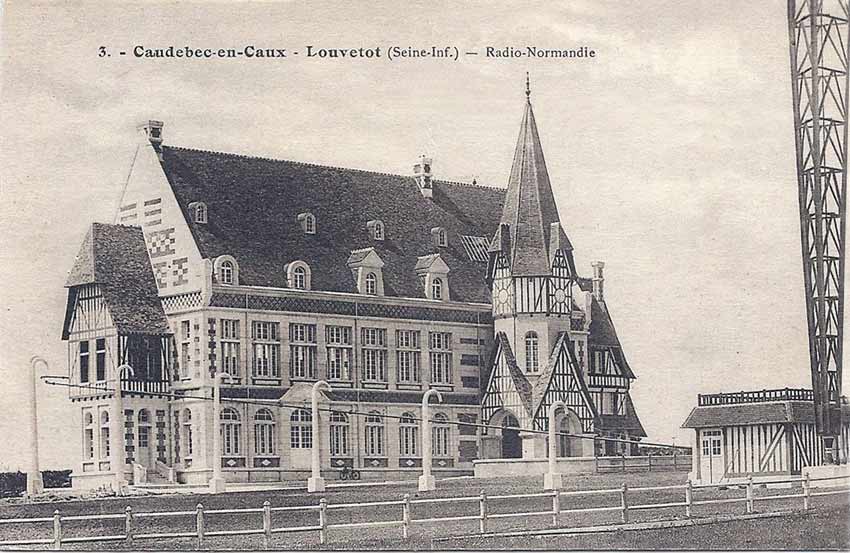
|

|
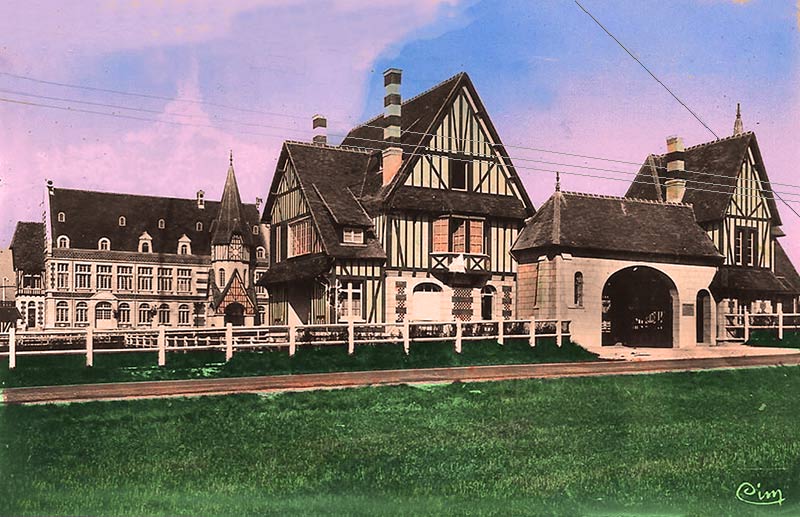
Une carte postale retrouvée avec la même vue "colorisée" de l'entrée
A postcard found with the same "colorized" view of the entrance |

Le portail d'entrée avec un gardien en uniforme (1938-39)
The entrance gate with a uniformed guard |
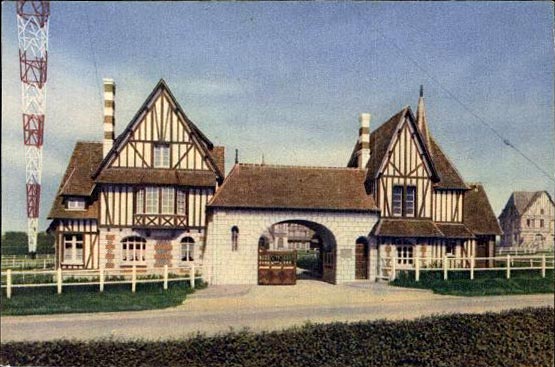
La même carte postale colorisée. Ttiens ! Bizarre le gardien s'est absenté entre-temps !
The same colorized postcard. Strange ! The guard has been absent in the meantime!
|
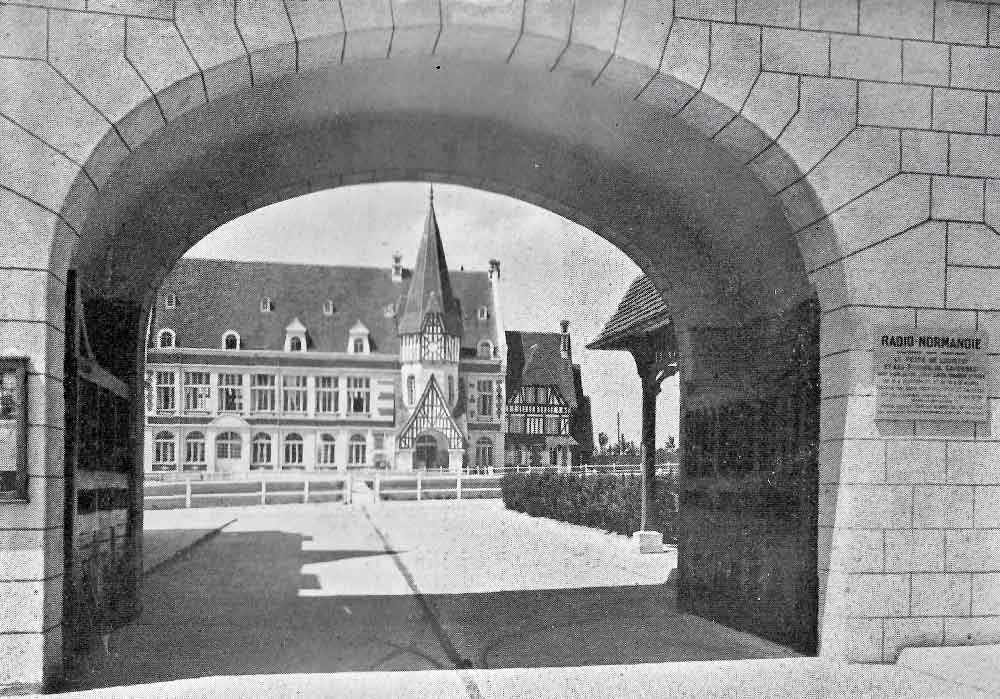
photo : "L'Illustration" juin 1939
Le porche d'entrée et le château du nouveau poste de Radio-Normandie. Une plaque indique les horaires de visite
The entrance porch and château of the new Radio-Normandie station. A plaque indicates the visiting hours
|
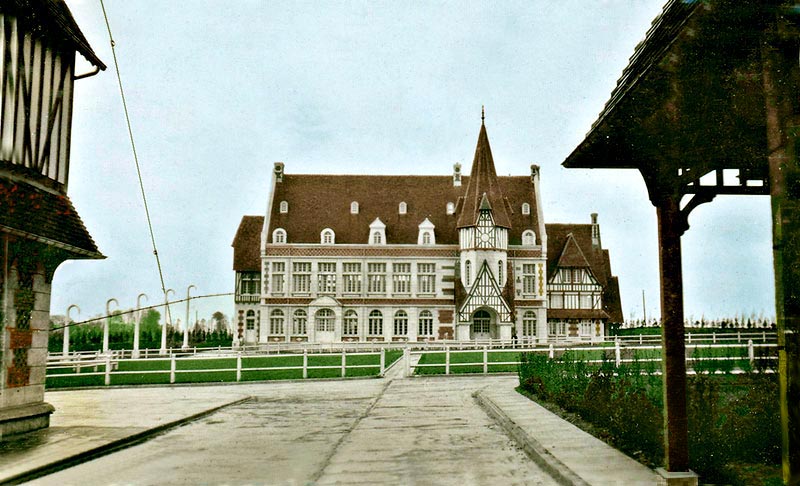
Vue du bâtiment principal depuis le porche de l'entrée (1938-39). Remarquez à gauche du bâtiment
le feeder d'alimentation de l'antenne soutenu par les crosses en ciment et un des trois haubans
This is a view of the main building from the entrance porch (1938-39). Note on the left side of the building
the antenna feeder is held up by cement brackets and one of the three guy wires.
|
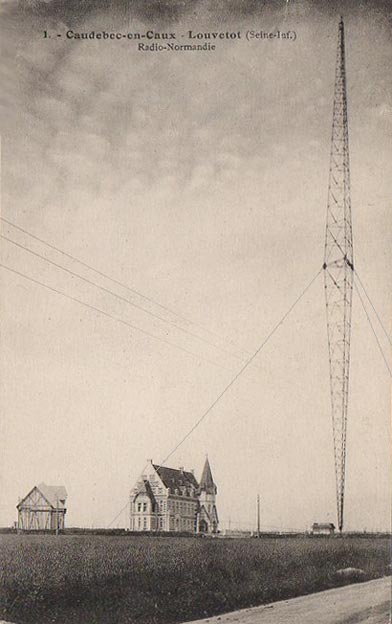
Retour en 1938 avec une vue surprenante au milieu de la plaine, sans la végétation luxuriante que l'on connaît aujourd'hui
Back in 1938 : a surprising sight in the middle of the plain, without the lush vegetation that we know today |
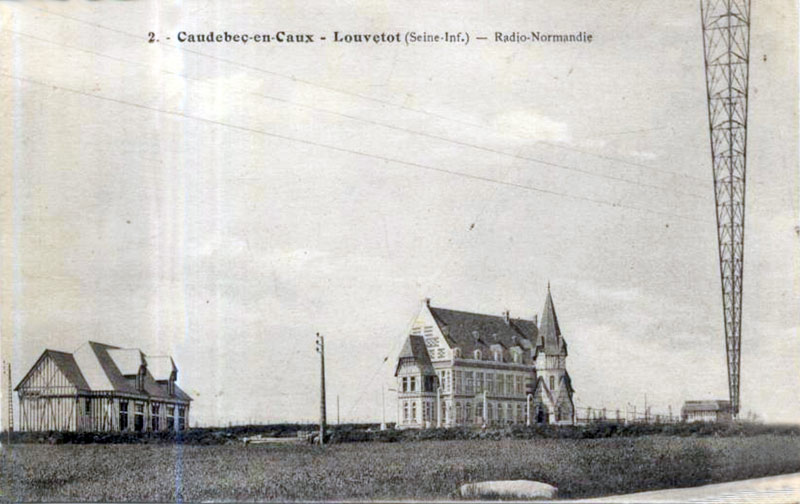
|
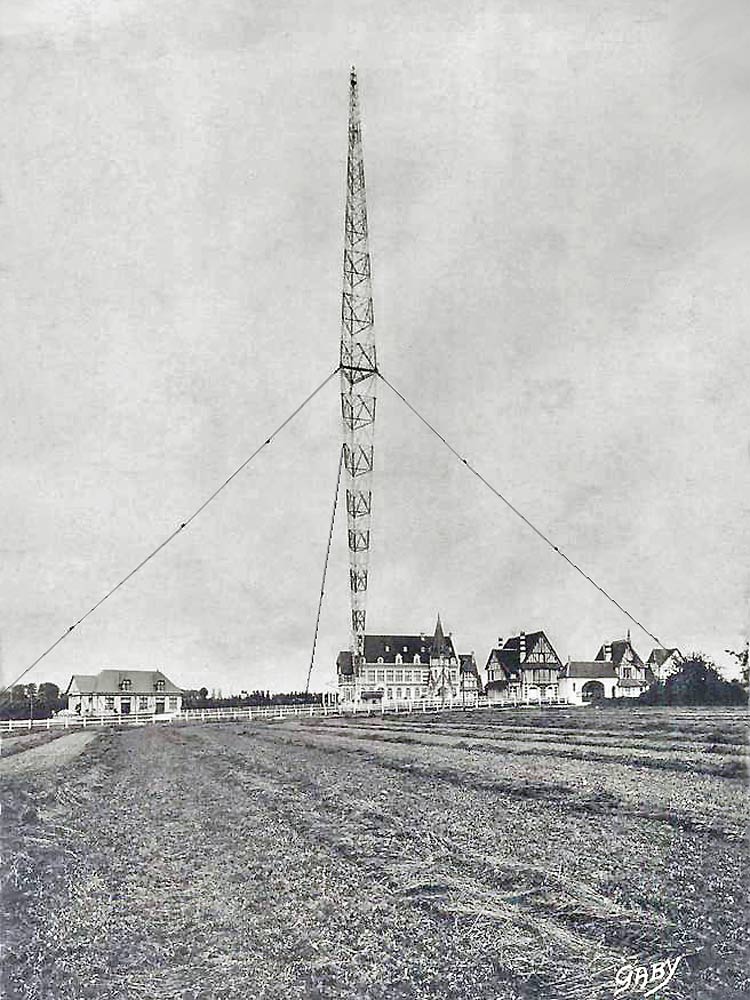
Vue générale de la station d'émission au bord de la route Caudebec-Yvetot
General view of the broadcast station along the road Caudebec-Yvetot
|

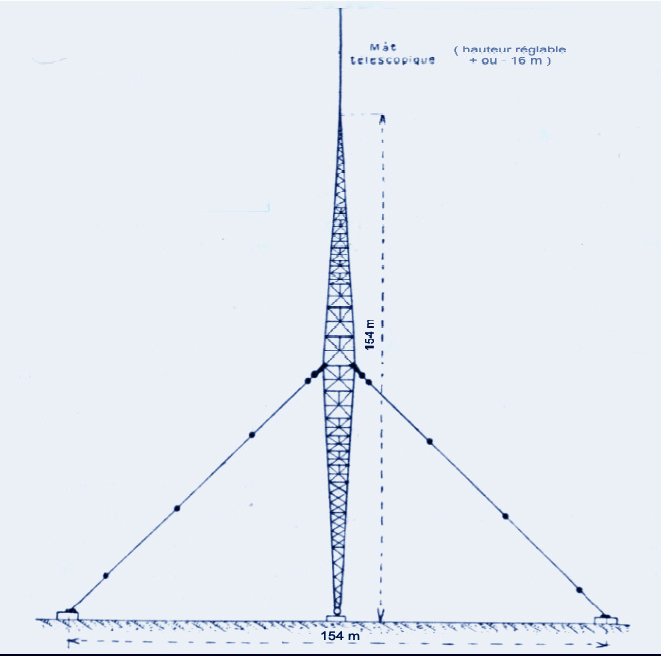
|
Le pylône anti-fading "Blaw-Knox" de 154 mètres en forme de losange avait la particularité d'être haubané à mi-hauteur.
Ce modèle de pylône très robuste était très en vogue dans les années 30. Il était supposé résoudre les inconvénients du fading (évanouissements intermittents du son pendant la réception). La hauteur pouvait être réglée à + ou - 17 mètres supplémentaires en fonction de la longueur d'onde utilisée (maximum : 170 m). Il existe encore quelques spécimens en Europe de l'Est notamment en Hongrie à > Lakihegy.
The 154 meter diamond-shaped “Blaw-Knox” anti-fading pylon had the particularity of being guyed halfway up. This very robust pylon model was very popular in the 1930s. It was supposed to solve the disadvantages of fading (intermittent fading of sound during reception). The height could be adjusted to + or - 17 meters additional depending on the wavelength used (maximum : 170 m). There are still a few specimens in Eastern Europe, particularly in Hungary.
|

L'émetteur 25 kW et son pupitre de commandes (occupent le premier étage)
The transmitter 25 kW and control desk (occupy the first floor ) |
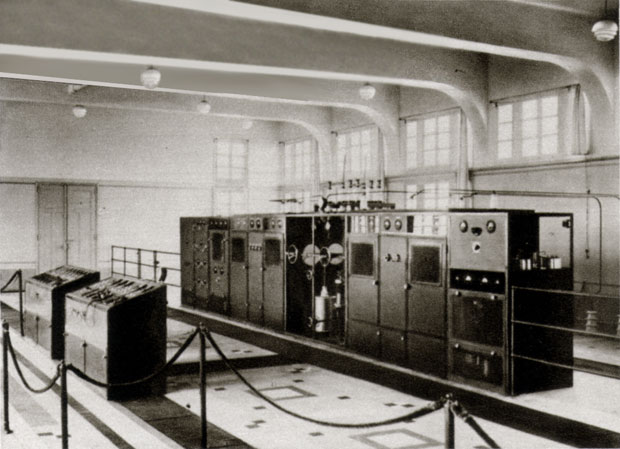
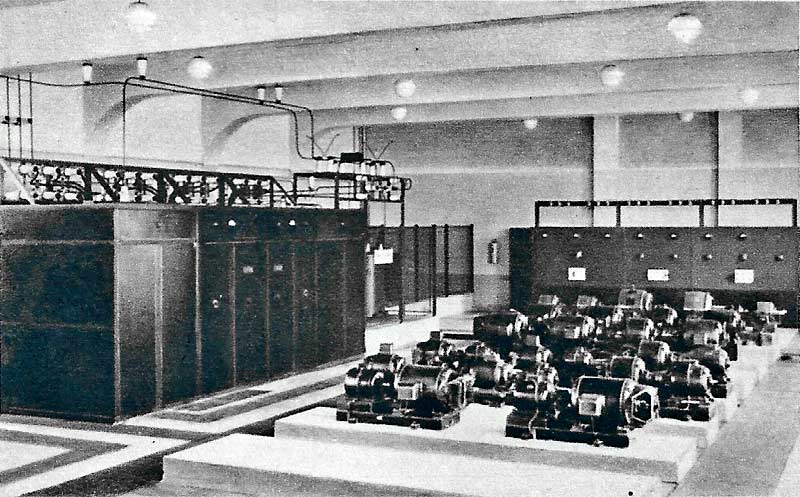
La salle des dynamos et des accumulateurs (pour le chauffage des filaments des lampes de l'émetteur).
The room of dynamos and accumulators (for heating of the filaments of the lamps of the transmitter).

Les 2 alternateurs Blackstone de 220 CV fournissant 300 ampères sous 220 volts dans la centrale électrique
The two 220 HP Blackstone alternators providing 300 amps at 220 volts in the power plant
|
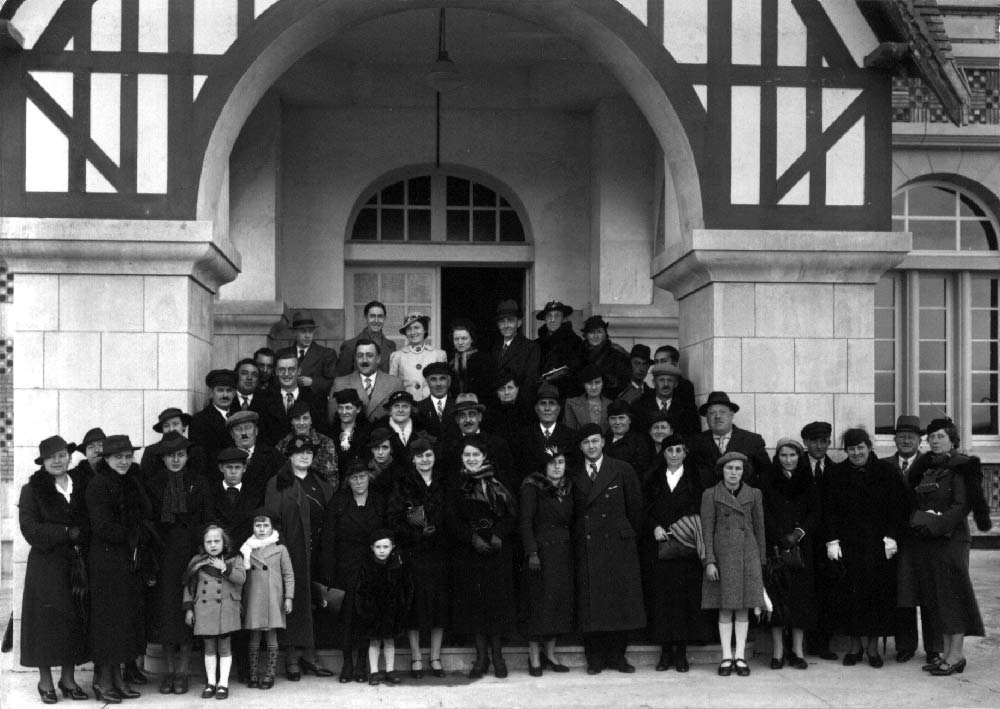
Les visiteurs sur le perron à Louvetot. Au milieu du deuxième rang, nous apercevons M. Fernand Le Grand, directeur (chapeau gris)
Visitors on the steps of the transmitter in Louvetot. In the middle of the 2nd row, we see Mr Fernand Le Grand, director (grey hat)
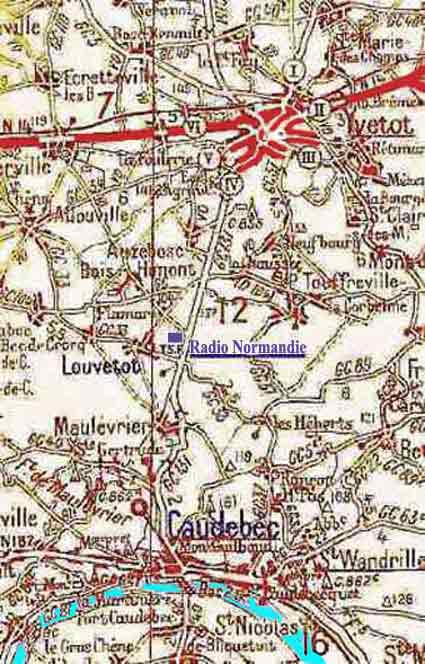
Sur cette vieille carte "Michelin", Louvetot à 6 km de Caudebec est le centre du monde... de la TSF !
On this old "Michelin" map, Louvetot (Seine Maritime) is situated at 6 km of Caudebec
in the heart of the Normandy and centre of the world... of Wireless!
|
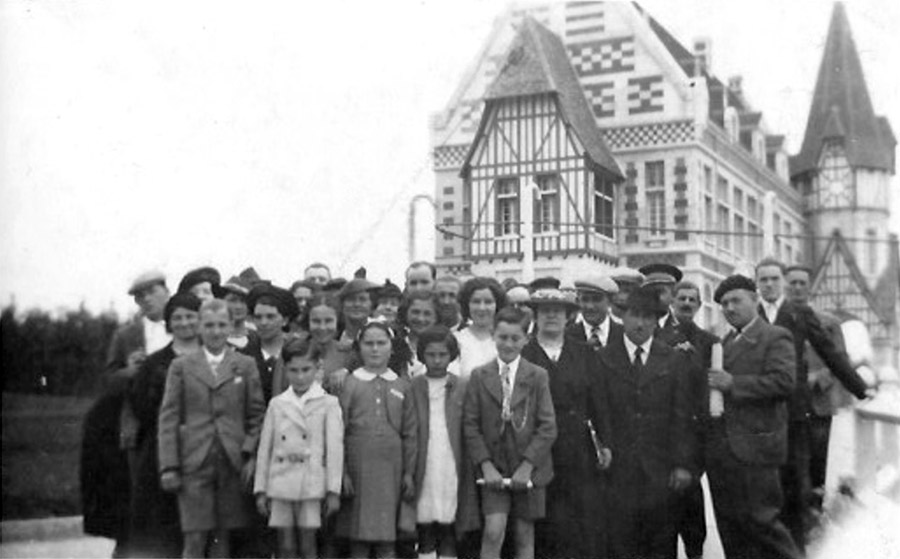
Souvenirs d'un voyage organisé en 1938 avec la visite des installations de Radio Normandie pour des agents PTT et leurs familles.
La vue est prise côté sud. Au-dessus des invités, on aperçoit le feeder (câble d'alimentation) qui relie l'émetteur au pylône
Memories of a trip organized in 1938 with a visit to the facilities of Radio Normandy for Post-Office agents and their families.
The view is taken from the south side. Above the guests, we see the power cable which connects the transmitter to the pylon
blanche |
Document transmis par Daniel Lefebvre : |
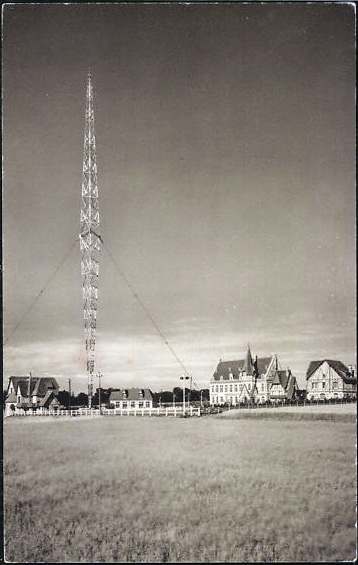 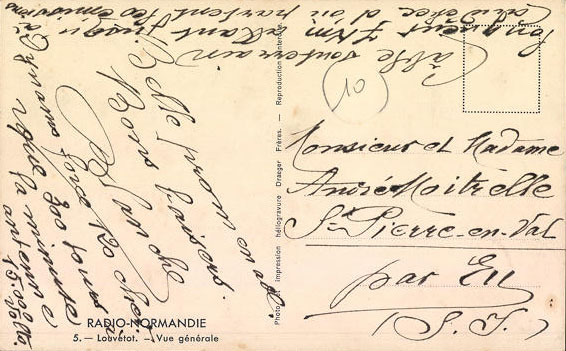
La carte postale dit : "Belle promenade, Bons baisers, (signé) Blanche.
A cette formule d'usage, Blanche qui a bien écouté les explications du guide-
technicien au cours de sa visite de Louvetot, fournit quelques détails techniques sur
les installations de l'émetteur de Radio-Normandie : Dynamo force 120 chevaux* -
Que 300 tours minute (?) - Antenne 15 000 volts - Câble souterrain, longueur
7 kilomètres allant jusqu'à Caudebec d'où partent les émissions.
* plus vraisemblablement : les alternateurs délivrent 220 CV et doivent tourner à 3 000 tours/mn
indispensables pour fournir un courant alternatif à 50 Hz (cf photos Louvetot)
|
The postcard says: “Beautiful walk, Good kisses, (signed) Blanche.
To this usual formula, Blanche who listened carefully to the guide's explanations-technician during his visit to Louvetot, provides some technical details on the installations of the Radio-Normandie transmitter: Dynamo forces 120 horses* - Only 300 rpm (!) - 15,000 volt antenna - Underground cable, length 7 kilometers going to Caudebec where the broadcasts leave.
* more precisely: the alternators deliver 220 HP and must rotate at 3,000 rpm necessary to provide alternating current at 50 Hz (see photos Louvetot)
|
Banquet de l'Association des Auditeurs le 3 décembre 1938
à l'Hôtel de la Poste - Fécamp
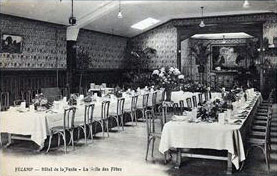
|

Quoi ! Pas de cidre ni de trou normand au menu ?
|
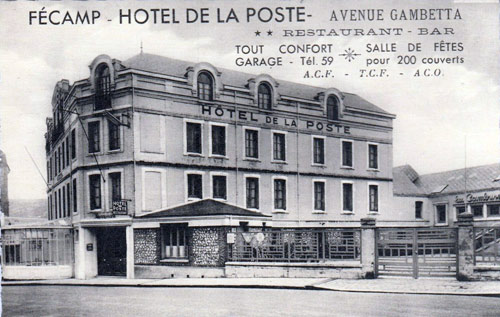
Le menu du banquet de l'Association des Auditeurs
de Radio Normandie qui s'est tenu le 3 décembre 1938 à l'Hôtel de la Poste à Fécamp, quelques jours avant le transfert de la station vers Louvetot et Caudebec
The menu of the banquet of the Radio Normandie Listeners Association held on December 3, 1938 at the Hôtel de la Poste in Fécamp, a few days before the transfer of the station to Louvetot and Caudebec
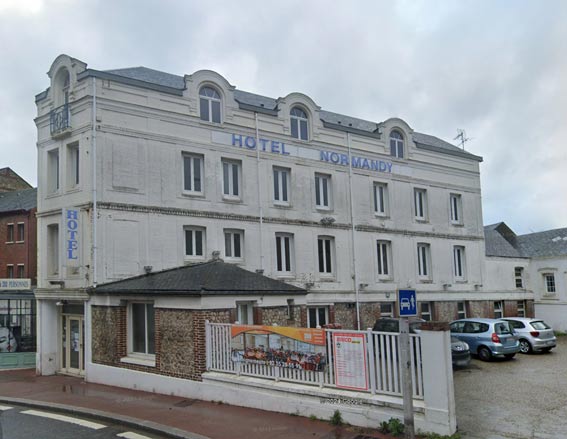
L'Hôtel de la Poste devenu "L'hôtel Normandy" de nos jours à Fécamp
The Hôtel de la Poste, now known as the "Hôtel Normandy" in Fécamp
|
Extrait de l'annuaire des cinq départements de la Normandie
publié par l'Association Normande (24.07.1938)
|
"Par une route assez pittoresque et aux abords boisés on arriva au Poste émetteur de Radio-Normandie à Louvetot.
Situé à 147 m. d'altitude, il occupe le point le plus haut du pays de Caux, à mi-distance entre Yvetot et Caudebec-en-Caux. La superficie du terrain occupé par l'émetteur est environ de 3 ha. Le style de tous les bâtiments est normand moderne.
A l'entrée se trouvent un garage et des logements pour une partie du personnel. Dans la partie Nord du terrain, s'élève la maison du chef de poste. A l'ouest et face à l'entrée, un grand bâtiment de 55 m. de façade contient l'émetteur proprement dit situé au premier étage et les machines d'alimentation dudit émetteur placé au rez-de-chaussée.
Devant ce bâtiment, se trouvent des bassins de réfrigération de 300 m3 d'eau.
L'émetteur placé dans ce bâtiment principal est relié au pylône par un appareil spécial appelé feeder qui conduit le courant au pied du pylône unique. Ce pylône de 154 m. de hauteur possède un mât télescopique de 17 m. qui permet l'accord du pylône avec la longueur d'onde.
Ce pylône n'est tenu que par trois haubans accrochés à celui-ci à la hauteur de 70 m. Cette masse qui pèse 65 tonnes repose sur des porcelaines fabriquées spécialement en Amérique, à très gros isolement et à peine plus grosses qu'une tête humaine.
Dans la partie basse du terrain se trouve une énorme réserve d'eau et un bâtiment contenant des moteurs Diesel qui permettent à Radio-Normandie d'être tout à fait indépendant, et de s'alimenter sur place en courant électrique.
Comme à cette hauteur, il aurait fallu forer un puits très profond, l'eau est récoltée précieusement sur toutes les toitures et sur une route en ciment qui fait tout le tour du terrain. La capacité totale des citernes atteint près de 3.000 m3.*
Cet émetteur moderne doté des derniers perfectionnements est relié au château de Caudebec-en-Caux où se trouvent les studios, par un câble construit spécialement et pupinisé. Ce câble entièrement souterrain comporte un certain nombre de paires spéciales à la radiodiffusion et même à la télévision. Il contient un certain nombre de paires téléphoniques pour permettre la liaison directe et automatique entre les différents services de l'émetteur de Louvetot et ceux des studios de Caudebec-en-Caux" (...) A suivre au chapitre Caudebec
Source: gallica.bnf.fr / Bibliothèque nationale de France, département Collections numérisées, 2008-115088
* A Louvetot, le réseau électrique fait son apparition dès 1930. L'adhésion au syndicat d'adduction d'eau potable est effectué en 1938. Construction et inauguration d'un château d'eau en 1952.
(d'après le livre de Mme J. Lebaillif - "Louvetot ma commune en pays de Caux" | "By a rather picturesque road and in the wooded surroundings, we arrived at the Radio-Normandy transmitting station in Louvetot.
Located at 147 m. of altitude, it occupies the highest point of the country of Caux, halfway between Yvetot and Caudebec-en-Caux. The area of the land occupied by the transmitter is approximately 3 ha. The style of all the buildings is modern Norman.
At the entrance there is a garage and accommodation for some of the staff. In the northern part of the land, stands the house of the postmaster. To the west and facing the entrance, a large building of 55 m. facade contains the actual transmitter located on the first floor and the power supply machines for said transmitter placed on the ground floor.
In front of this building, there are refrigeration basins of 300 m3 of water.
The transmitter placed in this main building is connected to the pylon by a special device called a feeder which leads the current to the foot of the single pylon. This pylon of 154 m. height has a telescopic mast of 17 m. which allows the tuning of the pylon with the wavelength.
This pylon is held only by three stay cables attached to it at a height of 70 m. This mass, which weighs 65 tons, is based on porcelain made especially in America, with very large isolation and barely larger than a human head.
In the lower part of the land, there is an enormous water reserve and a building containing Diesel engines which allow Radio-Normandy to be completely independent, and to be supplied with electric current on site.
As at this height, it would have been necessary to drill a very deep well, the water is collected preciously on all the roofs and on a cement road which goes all around the land. The total capacity of the tanks is nearly 3,000 m3.
This modern transmitter equipped with the latest improvements is connected to the castle of Caudebec-en-Caux where the studios are located, by a specially constructed and pupinized cable. This completely underground cable has a number of special pairs on broadcast and even television. It contains a certain number of telephone pairs to allow direct and automatic connection between the various services of the transmitter of Louvetot and those of the studios of Caudebec-en-Caux "(...)
(National Library of France)
* In Louvetot, the electrical network was installed in 1930. The municipality joined the drinking water supply association in 1938. A water tower was built and inaugurated in 1952.
(From the book by Ms. J. Lebaillif - "Louvetot, my commune in the Pays de Caux" |
|
Lundi 12 décembre 1938

Fin des émissions à Fécamp sur 212,6 m et reprise depuis Louvetot (Haute-Normandie) sur 274 m
On December 12, 1938, end of broadcasts in Fécamp on 212,6 meters and resumption from Louvetot on 274 meters
|
Le Lundi 12 décembre 1938, les travaux d'installation sont terminés à Louvetot et aux nouveaux studios de Caudebec (cf page Caudebec). Les émissions cessent à partir de Fécamp et reprennent aussitôt à Louvetot sur 274 m depuis la nouvelle station. Elles ont lieu toute la journée de 6h30 à 1 ou 2 h du matin.
Le nouveau poste sera inauguré officiellement le dimanche 4 juin 1939, mais les émissions cesseront le jeudi 7 septembre, la guerre mondiale étant de retour. |
On Monday December 12, 1938, the installation work was completed at Louvetot and at the new studios in Caudebec (see page Caudebec). The broadcasts cease from Fécamp and immediately resume at Louvetot over 274 m from the new station. They take place all day from 6.30 am to 1 or 2 am.
The new station will be officially inaugurated on Sunday June 4, 1939, but broadcasts will cease on Thursday September 7, the world war being back. |
|
 Message de Roy Plomley (avec xylophone) diffusé à partir du 12 décembre 1938 annonçant la nouvelle longueur Message de Roy Plomley (avec xylophone) diffusé à partir du 12 décembre 1938 annonçant la nouvelle longueur
d'onde de 274 m depuis le nouvel émetteur de Louvetot :
Message from Roy Plomley (with xylophone) broadcast from December 12, 1938 announcing the new wavelength
of 274 m from the new Louvetot transmitter:
(Durée 13') |
Radio Pictorial 30 décembre 1938
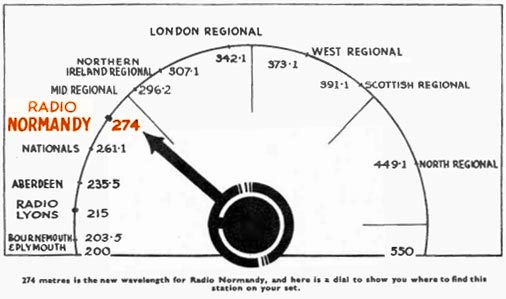
"274 mètres est la nouvelle longueur d'onde de Radio Normandie. Ce cadran montre
aux auditeurs britanniques où trouver désormais la station sur leurs récepteurs"

Survol promotionnel des plages de la côte sud de Grande Bretagne
Promotional overview of the beaches of the south coast of Great Britain
|
| |
|















 Le Centre émetteur de
Le Centre émetteur de 

 Par décret du 7 août 1935, tout s’arrange. Le transfert de la station de Fécamp à Caudebec-en-Caux est autorisé. Un terrain est acheté sur le plateau de Louvetot et la première pierre des nouvelles installations est posée le 30 novembre en présence de Marcel Pellenc
Par décret du 7 août 1935, tout s’arrange. Le transfert de la station de Fécamp à Caudebec-en-Caux est autorisé. Un terrain est acheté sur le plateau de Louvetot et la première pierre des nouvelles installations est posée le 30 novembre en présence de Marcel Pellenc





































